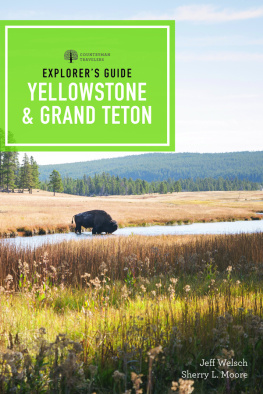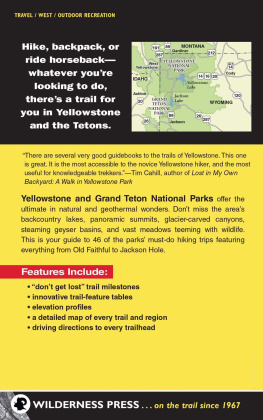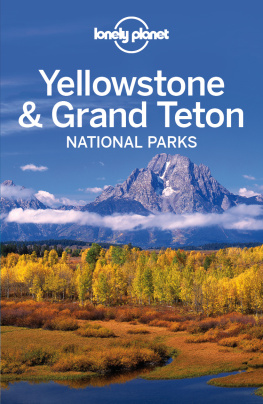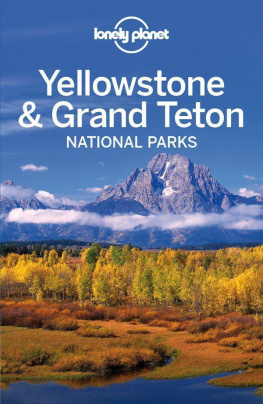Bibliography
Bauer, C. Max. Yellowstone: Its Underworld. University of New Mexico Press, 1948.
Brock, Thomas D. Life at High Temperatures. Yellowstone Association of Natural History, Sciences, and Education, 1994.
Craighead, Karen. Large Mammals of Yellowstone and Grand Teton National Parks. Craighead, 1978.
Fryxell, Fritiof. The Tetons: Interpretations of a Mountain Landscape. University of California Press, 1953.
Harry, Bryan. Teton Trails: A Guide to the Trails of Grand Teton National Park. Grand Teton Natural History Association, 1966.
Lange, Joseph K. How to Photograph Landscapes. Stackpole Books, 1998.
Love, J. D., and Reed, John C., Jr. Creation of the Teton Landscape. Grand Teton National History Association, 1976.
National Park Service. Grand Teton: Official National Park Handbook. National Park Service, 1984.
Schullery, Paul. The Bears of Yellowstone. Yellowstone Library and Museum Association, 1980.
Shaw, Richard J. Wildflowers of Yellowstone and Grand Teton National Parks. Wheelwright Lithographing Company, 1956.
Wuerthner, George. Yellowstone: A Visitors Companion. Stackpole Books 1992.
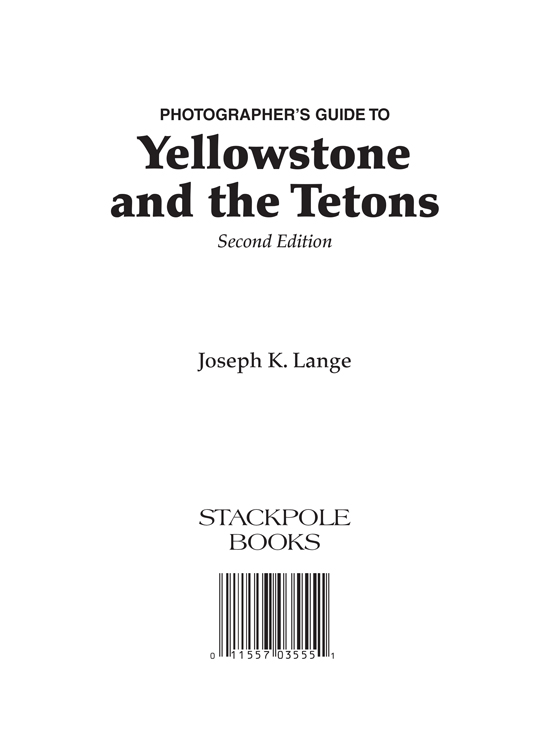
For my parents, Lois and Ken,
who introduced me to Yellowstone and the Tetons.
Copyright 2009 by Stackpole Books
Published by
STACKPOLE BOOKS
5067 Ritter Road
Mechanicsburg, PA 17055
www.stackpolebooks.com
All rights reserved, including the right to reproduce this book or portions thereof in any form or by any means, electronic or mechanical, including photocopying, recording, or by any information storage and retrieval system, without permission in writing from the publisher. All inquiries should be addressed to Stackpole Books, 5067 Ritter Road, Mechanicsburg, PA 17055.
Printed in China
Cover design by Tessa J. Sweigert
Cover photos by Joseph K. Lange
front: Oxbow Bend in autumn, Grand Teton National Park
back: Howling coyote in winter
10 9 8 7 6 5 4 3 2 1
Second edition
Library of Congress Cataloging-in-Publication Data
Lange, Joseph K.
Photographers guide to Yellowstone and the Tetons / Joseph K. Lange. 2nd ed.
p. cm.
Includes bibliographical references.
ISBN-13: 978-0-8117-3555-1
ISBN-10: 0-8117-3555-9
1. Yellowstone National ParkGuidebooks. 2. Grand Teton National Park (Wyo.)Guidebooks. 3. PhotographyYellowstone National ParkGuidebooks. 4. PhotographyWyomingGrand Teton National ParkGuidebooks. I. Title.
F722.L27 2009
779'.99178750434dc22
2008023578
eBook ISBN 978-0-8117-4351-8
Preface
M y interest in Yellowstone and the Tetons began at the age of ten, when my family, who lived in a Chicago suburb, vacationed in these parks. I found the beautiful scenery, thermal features, and fields of flowers new and interesting. Wildlife was abundant, and back in the 1950s, when I was being introduced to these parks, bears were everywhere. On one visit, I counted over one hundred bears.
I wanted to record the beauties of this fascinating area. My mother, an art teacher, had taught me the principles of composition and the basics of drawing and painting. However, I didnt have the patience to spend a long time on one work of art. I had seen the beautiful landscapes of Ansel Adams, and I decided that photography would be my chosen form of artistic expression. So, on our next trip west, I took along a Kodak Pony camera with adjustable focus, shutter speed, and aperture and taxed my fathers patience with requests to stop and photograph everything.
Over the years, my appreciation and knowledge of Yellowstone and the Tetons have grown. Ive photographed in each park at all seasons of the year, each of which has its own unique beauty and photographic opportunities. For the last eighteen years, Ive led two or three photographic workshops to Yellowstone and the Tetons each year.
In the Photographers Guide to Yellowstone and the Tetons, I reveal my favorite photographic locations in each park and give advice on when and how the best pictures can be obtained. The history, ecology, botany, geology, and zoology of Yellowstone and the Tetons are beyond the scope of this book. For more details on these interesting subjects, I recommend Yellowstone: A Visitors Companion, by George Wuerthner (Stackpole Books, 1992).
This book also does not cover the basic artistic and technical aspects of nature photography. It is geared for the advanced amateur who already understands basic photography. For more basic information on composition, lighting, exposure, and equipment, see How to Photograph Landscapes (Stackpole Books, 1998).
I would like to thank Mark Allison and David Richwine, my editors at Stackpole, for their assistance in turning my rough manuscript into a helpful and informative book. Their good cheer and constructive comments made writing it a pleasure.
Why to Photograph in Yellowstone and the Tetons
Y ellowstone and the Grand Tetons have the greatest concentration of varied and spectacular nature subject material of any area in the United Statesmaybe even the world. Only three other areas on earthSiberia, New Zealand, and Icelandhave a significant concentration of thermal features. Yellowstone has by far the largest and most spectacular assemblage of geysers, hot springs, mud pots, terraces, and fumaroles. The shapes, colors, and patterns associated with these features challenge the photographers compositional skills. The eruptions of the hundreds of geysers in Yellowstone present a symphony of action and form. Some are powerful and others are delicate, but most make interesting photographic subjects. Dramatic and varied lighting may occur, depending on the vantage point and time of day or year. The runoff streams that flow from the geysers and hot springs are colorful, interesting, and ever changing. Algae and bacteria in Yellowstones many hot pools, terraces, and runoff streams create a kaleidoscope of yellows, oranges, reds, and browns. If the water is too hot for these organisms to grow, the pool reflects the color of the sky.
Yellowstone also has an outstanding number, quality, and variety of waterfalls. This high volcanic plateau receives large amounts of moisture in the form of winter snows and summer rains. Runoff from the rugged terrain feeds numerous rushing streams. Smaller streams have graceful, lacy cascades. More powerful waterfalls are found on some of the major rivers and streams. The combination of thermal activity and the cutting action of the Yellowstone River has formed the colorful and spectacular Grand Canyon of the Yellowstone River.
In Yellowstone, unexpected photographic opportunities abound. Due to widespread thermal activity, high elevations, and abundant precipitation, foggy conditions are common, especially during the early-morning hours, and youll have opportunities to photograph trees and animals in the fog, the sun rising through the mist, frosty leaves, and dewy spiderwebs.
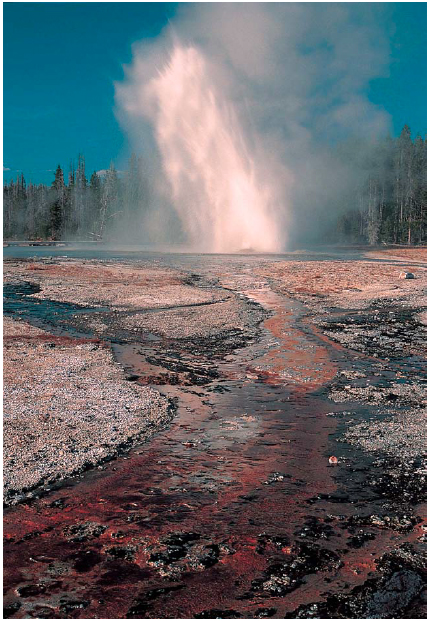
This viewpoint of Daisy Geyser was chosen because of the colorful runoff stream leading up to the geyser. The focus was set at the hyperfocal distance to render both near and far objects in sharp focus. A polarizing filter darkened the sky and made all the colors richer, and an enhancing filter emphasized the reds in the runoff stream.



